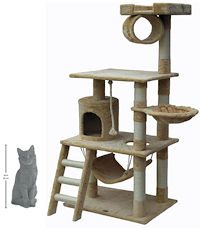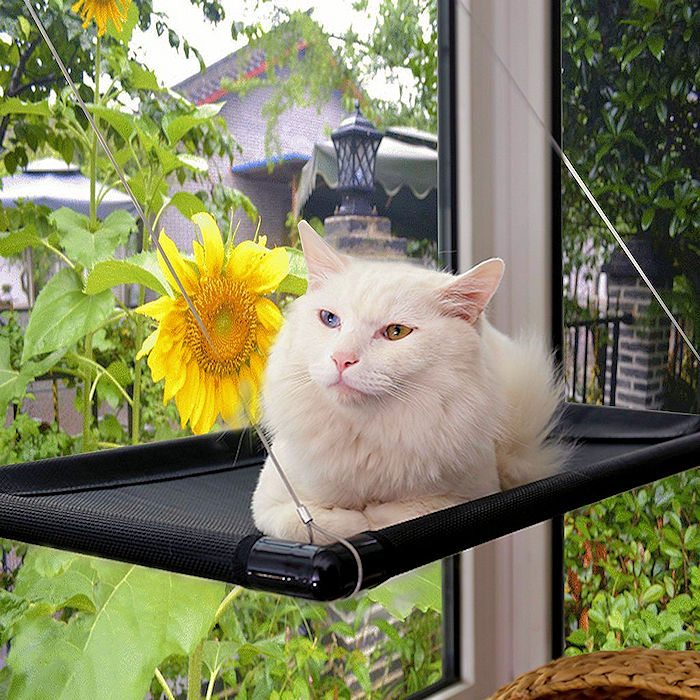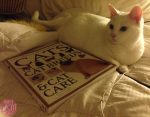|
|
 Remember, before adopting you new cat, your new pet may live to be 15-20 years old. Try to honestly look at yourself and your family. Is your living situation suited for a long-term situation? If your getting a cat, you might want to even consider getting two. They tend to entertain each other and keep each other company. Remember, before adopting you new cat, your new pet may live to be 15-20 years old. Try to honestly look at yourself and your family. Is your living situation suited for a long-term situation? If your getting a cat, you might want to even consider getting two. They tend to entertain each other and keep each other company.
Finances
Financial considerations are important as well. Take into account vet bills, food, litter, and toys. An estimation of cat care is about $500 per year.
Time
There is also a certain amount of your time involved. Although cats are often portrayed as being self-maintained, they do need a stimulating environment to prevent boredom. Lonely cats show their stress by over-eating, scratching problems, over-grooming, soiling, and depression.
Cat Age
Everybody loves an adorable, soft kitten! Who wouldn’t? They are irresistible. From a kittens point of view everything is made for them to play with. Yarn is there to tug at and bat at, It is important to kitten proof your house to prevent injuries to your new friend.
Cat Appearance
Long-haired cats will require more grooming and the hair they shed will be noticeable. Will that bother you? But, both long and short-haired cats shed and enjoy grooming.
Healthy cats will have shiny coats, bright eyes, and clean ears and noses. They are aware of their surroundings.
 Cat Gender Cat Gender
When cats are neutered the gender doesn’t matter a great deal. The only major difference is that the male cats tend to grow larger than female cats.
Personality
Just like people, cats can be timid, friendly, quiet, vocal, or independent. Affectionate cats will expect a lot of attention. Cats that are more independent will adjust better to being alone.
 The KodKod Cat is a mysterious South American wild cat because not much is known about them due to insufficient research and data analysis. According to the IUCN/SSC Cat Specialist Group, the KodKod Cat is placed on Appendix II of the Convention of International Trade in Endangered Species. They are, however, similar in appearance to Geoffrey’s Cat. They are also much smaller than the average exotic cat, and can grow up to an average lifespan of ten years generally. It is, however, the smallest wild cat known that is living in America right now. The KodKod Cat is a mysterious South American wild cat because not much is known about them due to insufficient research and data analysis. According to the IUCN/SSC Cat Specialist Group, the KodKod Cat is placed on Appendix II of the Convention of International Trade in Endangered Species. They are, however, similar in appearance to Geoffrey’s Cat. They are also much smaller than the average exotic cat, and can grow up to an average lifespan of ten years generally. It is, however, the smallest wild cat known that is living in America right now.
There is still quite a lot of air of mystery around the KodKod Cat because honestly not a lot of information is known about them. Scientists are still attempting to study and observe this specie of exotic cat to discover more of its mating habit, diet, and behavioral patterns. Maybe, one day, we will become more familiarized with this specie of exotic cat; however, currently, we still have a lot of work to do in order to get there.
The KodKod Cat is much smaller than the average exotic cat with lengths recording up to a foot and a half long, and weighing in at only 5 pound or less. They are one of the smallest types of exotic cats which are found to exist in the western hemisphere of the Earth. Generally, they have nice eye colors which are a grayish brown color to a buff red color. They have distinct white spots on their ears and attractive black rings on their long legs. Because of their small size, they generally will not pick on or even eat any animal that is around the same site as him.
The KodKod cat prefers to live in the wet forests; this is because their food is in more abundance there, and chances of them being able to live in happiness with sufficient food were a lot higher. They are also a nocturnal animal, and will go hunt at night. They will not go out to hunt in the broad daylight. They do, however, have strong legs and are known for their ability to climb; in fact, they are great climbers. It is important not to worry too much about the KodKod cat though as they have great adaptive ability skills.
The KodKod Cat generation is highly affected by deforestation which will kill off and unearth the rodents which live in that area. Without prey, they have no more food, and will starve; however, luckily, they have quite good adaptive skills. They can live in many different environments, and as long as mice are present or any rodent, they can live off of them. Another population decrease reason is that sometimes KodKod Cat will gang up and attack farmer’s livestock causing the farmer’s to kill them to protect their livestock.
 Acute collapse in cats occurs when a cat suddenly falls and is not capable of getting back up due to a “loss of strength”. There are two types of acute collapse in cats, hind limb collapse and complete collapse. Hind limb collapse occurs when the cat ends up in a sitting position after falling and complete collapse occurs when the cat ends up in a lying position after the fall. The cat will actually lose consciousness, but the amount of time that the cat is out will vary. Cats can recover quickly and are normal looking and acting just seconds after experiencing an acute collapse or they can take longer to recover. Acute collapse in cats occurs when a cat suddenly falls and is not capable of getting back up due to a “loss of strength”. There are two types of acute collapse in cats, hind limb collapse and complete collapse. Hind limb collapse occurs when the cat ends up in a sitting position after falling and complete collapse occurs when the cat ends up in a lying position after the fall. The cat will actually lose consciousness, but the amount of time that the cat is out will vary. Cats can recover quickly and are normal looking and acting just seconds after experiencing an acute collapse or they can take longer to recover.
Acute collapse in cats can be caused by many disorders. These include disorders of the cat’s nervous system, musculoskeletal system, circulatory system or respiratory system. If the nervous system disorder is the cause, then the cat’s nerves, spinal cord or brain may be involved. If the musculoskeletal system is the cause, then the cat’s muscles, joints or bones may be involved. If the cat’s circulatory system is the cause, then the cat’s blood, blood vessels or heart may be involved. And, if the cat’s respiratory system is the cause, then the cat’s lungs, throat, nose or mouth may be involved.
Signs or symptoms that cat owners can watch to determine if their cat has acute collapse are the cat quickly and suddenly sitting down or the cat will suddenly lie down. Whether sitting or lying, the cat will be unable to get up. When this occurs, it is time to contact a vet who will treat the cat, as these are not normal movements that cats have.
Acute collapse in cats can be a symptom of a very serious medical condition. With this in mind, it is always best to contact a vet if the cat owner knows or suspects that their cat has suddenly collapsed. There are many causes for acute collapse that involve most of the systems in the cats body as discussed earlier. All of these disorders are very dangerous in a cats life, making it important to be aware of what is happening with the cat. One more reason that cat owners should always be aware of any changes in their cat’s life, or as much as they can. This will definitely be easier if their cat is an indoor cat instead of an outdoor cat.
 Marbled Cat Photo by R. Pandit from http://www.catsg.org/index.php?id=122 There are so many species of exotic cats out there, and surprisingly we probably have not sighted them all yet. The Marbled Cat is an exotic and rare cat and anyone who is able to see them is rather lucky as they are not often seen. They are another mysterious member in the exotic cat family. The Marbled Cat can be found in Southeast Asia, and are a smaller than average breed of exotic cat compared to the others one out there with a lifespan of about 12 years. Because of their rarity, they are actually classified as an endangered species.
The Marbled Cat is a hard sight to see, but you can start at Southeast Asia where they inhabit. According to Central Pets, they are sometimes seen as far south as Sumatra and Borneo; however, sightings are rather infrequent, and thus, the exact numbers in their populations are unknown. All we know is that they are an endangered species of exotic cat which we really need to work to help protect. Because sightings are infrequent, and that there are not many around, there are not many studies of them at all.
For those who have seen the Marbled Cat, they will generally describe them as large house-hold pet cats resembling the Clouded Leopard; however, they have softer patterns on their coat than the Clouded Leopard. Also, they have more spotting on their legs. They definitely are rather large. Mature individuals in this specie can measure up to 60 centimeters long! However, while they may be quite large, they are not actually heavy and will weigh only about eight pounds or so. The Marbled Cat is known for their beautiful coat which is a brownish-gray color generally although it can range to a striking yellow. One of their main distinctive traits is that their tails are long and bushy, and they can sometimes be as long as them in length!
 Photo by S. Kennerknecht from http://www.catsg.org/index.php?id=122 There is not much known about the diet or the hunting abilities of the Marbled Cat; however, we do know that they feed on reptiles, squirrels, birds and bird eggs. They will spend most of their time in the trees, and will even make their home in the forested areas; sometimes, high up in the trees. They have been known to hunt on the ground, and in the trees depending on their diet and what they are looking to achieve.
Each litter that they have usually will have one to seven kittens although four seems to be the average for them. The Marbled Cat will actually be pregnant for 81 days before the finally go into labor.
From Cat Specialist Group Website: http://www.catsg.org/index.php?id=122
The ecology and behaviour of the marbled cat are poorly known. It was originally thought to be primarily crepuscular and nocturnal. A radio collared individual in Thailand was mainly active at night, and several observations in Kalimantan were in the late evening. However, recent camera trap studies on Sumatra and Borneo, and in Thailand and Lao PDR indicate that the marbled cat may is primarily diurnal.
The marbled cat is thought to be a forest-dependent species and is known as a very good climber, able to climb down a tree headfirst. It is referred to as the Old World margay for its arboreal activity. The marbled cat was thought to spend most of its time in the trees, and in the past this has been thought to account for the rarity of sightings. An individual was observed at night resting on a tree branch 25m above the ground in the Deramakot Forest Reserve in Borneo. It subsequently climbed among the branches and descended the tree face first to escape the spotlight. However, there have now been numerous camera trap photographs of the species on the ground, and several sightings as well. In 2008, a primate researcher observed an adult individual resting on the ground under a fruiting tree. The individual remained resting at a distance of 1.2 m from the observer for over an hour before calmly moving off.
From Cat Specialist Group Website: http://www.catsg.org/index.php?id=122
Who doesn’t love cats? They are cute, fuzzy, friendly and can melt your heart away. They entertain you with their cute little tricks, they make you burst out in laughter with their ridiculous antics, and they are just outright adorable. Most of the time, that is! As lovable as cats are, they can drive you crazy too. They love to claw at furniture, bite curtains, and don’t even get me started on carpet poop! A little bit of advice: Never leave your cat home for a week straight. You’ll come home to a poop fest!
Cats are thankfully intelligent enough that you can easily train them to behave correctly. Believe it or not, you can even toilet train cats. Yes, you heard me correct! YOU CAN TOILET TRAIN YOUR KITTY! Training a cat to ‘go’ in the toilet is actually pretty simple. All you really need is determination combined with a heap of patience. Make sure that your cat at least knows how to use a litter box before you begin. That will knock out about 50% of your work.
First, set your kitty’s litter box in the bathroom near the toilet. Leave it there for a week and let your cat become accustomed with the bathroom. Next, gradually (day by day) inch the box nearer to the toilet. As the litter box gets closer, start to reduce the gravel in the litter box. By the end of the week, the litter box should be right next to the toilet.
Now we get to the fun part. Each day, put another book underneath the litter box. Within a week, it should be level with the toilet. Next, raise the seat and cover the opening with some wax paper. Make sure you tape the paper to the bowl, lest it fall in. Then bring the seat back down and start inching the box towards the seat. Once again, keep reducing the amount of gravel. Eventually, the box should be on top of the toilet seat.
By now, there should be almost no gravel left in the litter box.
After two more days, get rid of the litter box. Go back to the toilet seat and carve a small hole in the center of the wax paper. If your cat has been paying attention, it should start pooping through the hole. Let it do so for about a week. Then, start widening the hole each day. By the end of this week, the hole will be gone and your cat should be officially potty trained!
|
|
 Remember, before adopting you new cat, your new pet may live to be 15-20 years old. Try to honestly look at yourself and your family. Is your living situation suited for a long-term situation? If your getting a cat, you might want to even consider getting two. They tend to entertain each other and keep each other company.
Remember, before adopting you new cat, your new pet may live to be 15-20 years old. Try to honestly look at yourself and your family. Is your living situation suited for a long-term situation? If your getting a cat, you might want to even consider getting two. They tend to entertain each other and keep each other company. Cat Gender
Cat Gender







 The KodKod Cat is a mysterious South American wild cat because not much is known about them due to insufficient research and data analysis. According to the IUCN/SSC Cat Specialist Group, the KodKod Cat is placed on Appendix II of the Convention of International Trade in Endangered Species. They are, however, similar in appearance to Geoffrey’s Cat. They are also much smaller than the average exotic cat, and can grow up to an average lifespan of ten years generally. It is, however, the smallest wild cat known that is living in America right now.
The KodKod Cat is a mysterious South American wild cat because not much is known about them due to insufficient research and data analysis. According to the IUCN/SSC Cat Specialist Group, the KodKod Cat is placed on Appendix II of the Convention of International Trade in Endangered Species. They are, however, similar in appearance to Geoffrey’s Cat. They are also much smaller than the average exotic cat, and can grow up to an average lifespan of ten years generally. It is, however, the smallest wild cat known that is living in America right now. Acute collapse in cats occurs when a cat suddenly falls and is not capable of getting back up due to a “loss of strength”. There are two types of acute collapse in cats, hind limb collapse and complete collapse. Hind limb collapse occurs when the cat ends up in a sitting position after falling and complete collapse occurs when the cat ends up in a lying position after the fall. The cat will actually lose consciousness, but the amount of time that the cat is out will vary. Cats can recover quickly and are normal looking and acting just seconds after experiencing an acute collapse or they can take longer to recover.
Acute collapse in cats occurs when a cat suddenly falls and is not capable of getting back up due to a “loss of strength”. There are two types of acute collapse in cats, hind limb collapse and complete collapse. Hind limb collapse occurs when the cat ends up in a sitting position after falling and complete collapse occurs when the cat ends up in a lying position after the fall. The cat will actually lose consciousness, but the amount of time that the cat is out will vary. Cats can recover quickly and are normal looking and acting just seconds after experiencing an acute collapse or they can take longer to recover.

